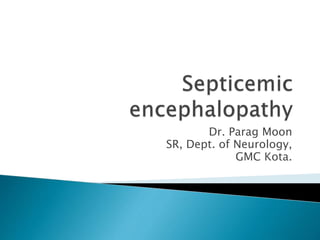
Septicemic encephalopathy
- 1. Dr. Parag Moon SR, Dept. of Neurology, GMC Kota.
- 3. Defined as brain dysfunction due to sepsis and SIRS Also called sepsis-associated delirium Clinically, acute impairment in the level of consciousness and confusion (manifested by alteration in attention, disorientation and concentration up to deep coma in more severe cases)
- 4. 9 -71% of patients with sepsis develop SE Patients With known CNS pathology are at greater risk for SE Often described as a reversible syndrome New studies show prolonged cognitive impairment and depressive symptoms in sepsis survivors 63% mortality rate reported in SE patients with reduced Glasgow Coma Scale to 3-8 points
- 5. 1) Oxidative stress occurs early (<6h) 2) Cytokines Pro-inflammatory cytokines (tumor necrosis factor (TNF), Interleukin (IL)-1ß, IL-6) are significantly increased in SE Contribute to the development of longterm cognitive dysfunction and behavioral symptoms
- 6. 3) Complement cascade Excessive complement activation can also produce reactive oxygen species, can facilitate proinflammatory mediators and causes edema, cell necrosis or apoptosis
- 7. Diminished cholinergic innervation - hippocampal, parietal and prefrontal cortex-incapacities of memory functions Dysfunction of the neural circuits between medial temporal lobe, posterior parietal cortex and dorsal prefrontal cortex by disconnection from general activating projections from the ascending reticular activating system (ARAS)- delirium and long-term impairment in SE patients
- 8. Cerebral endothelial dysfunction, microvasculature and blood-brain-barrier (BBB) changes Impaired nutrition delivery and removal of metabolic waste products as well as increased permeability Inappropriate blood supply to neurons may play an important role for SE
- 9. Aromatic amino acids (AAA) Normally restricted by BBB Increased in SE patients and correlate with severity of encephalopathy May act as false neurotransmitter and/or disturb neurotransmitter synthesis Increased serum levels of phenylalanine, ammonia, and tryptophan with influence on procalcitonin and IL-6 levels contributing to SE development.
- 11. Mild patients demonstrate a fluctuating confusional state and inappropriate behavior. Inattention and writing errors (including spelling, writing full sentences, orientation of writing on the page). More severely affected show delirium, an agitated confusional state or coma.
- 12. Most common motor sign is paratonic rigidity or gegenhalten, a resistance to passive movement of limbs that is velocity-dependent Asterixis, multifocal myoclonus, seizures and tremor are relatively infrequent Cranial nerve functions are almost invariably spared. Lateralized features are almost never encountered
- 13. Clinical or laboratory evidence of peripheral nerve dysfunction, namely critical illness polyneuropathy, is found in 70% patients. It is axonal type, later in onset and much slower to recover than the encephalopathy
- 15. No specific test available 1) Electroencephalography (EEG) Most sensitive diagnostic tool Normal, diffuse slowing, excessive theta, predominantly delta, triphasic waves, and suppression or burst suppression Non-specific
- 17. 2) Short-latency and long-latency-SEP measurement provide a valuable estimation of SE severity 3) CSF examination Total protein may be elevated in severe SE cases, cell counts and microbiological cultures remain normal Used to exclude direct infection in suspected meningoencephalitis.
- 18. 4) Serum markers S100B and neuron-specific enolase (NSE) are elevated in adults and children Do not correlate with severity of SE
- 19. 1)CT scans mostly normal White matter hypodensities are reported 2)MR imaging Various degrees of leukencephalopathy as well as multiple ischemic strokes Patients without MR abnormalities survived without sequelae, while those who died showed clear MRI lesions Mainly within the white matter Corresponded to vasogenic edema, probably reflecting blood–brain barrier breakdown.
- 20. Infarction of basal ganglia secondary to fibrinoid necrosis and thrombosis of small vessels neuropathologically a posterior reversible encephalopathy syndrome (PRES) MR angiography in this study revealed vasospasm and vessel “pruning”,
- 23. Cerebral hemorrhage, ischemic infarcts and central pontine Myelinolysis(17%) Disseminated micro-abscesses (~67%) Ischemic and apoptotic neurons were found in paraventricular and supraoptic nuclei as well as in locus coeruleus.
- 24. No specific treatment options for SE. Most importantly, adequate and immediate therapy of the underlying sepsis syndrome and supportive intensive care are required Administration of a mixture of amino acids with high concentrations of branched-chain amino acids
- 26. Activated protein C, that affect or counteract the procoagulant state in sepsis may be directly or indirectly beneficial to brain function in sepsis Ascorbate (ascorbic acid 20mg/kg) is antioxidant. Found useful in animal model.
- 27. Experimental treatment-Magnesium, glutamate release inhibitor riluzole or an antioxidant treatment, selective antagonists of pro-inflammatory cytokine receptors Coupled plasma filtration adsorption, an extracorporal therapy, aimed at the nonspecific removal of cytokines and mediators involved in systemic inflammation
- 28. Thanks
- 29. Neurological Sequelae of Sepsis: I) Septic Encephalopathy; The Open Critical Care Medicine Journal, 2011, Volume 4 Sepsis-associated encephalopathy; Neurol J Southeast Asia 2003; 8 : 65 – 76 Understanding brain dysfunction in sepsis; Sonneville et al.; Annals of Intensive Care 2013, 3:15 Sepsis-Associated Encephalopathy: Review of the Neuropsychiatric Manifestations and Cognitive Outcome; J Neuropsychiatry Clin Neurosci 23:3, Summer 2011